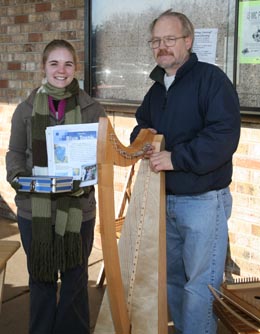
Many areas lack reliable access to care info Imagine your doctor not having access to the Internet or a set of medical reference books? That is the situation faced by many health professionals in many countries around the world, including Africa. As a way to bring necessary information to the medical professionals in those areas, the World Health Organization (WHO) developed a Blue Trunk Library project through which donations are solicited to fill a blue metal trunk with books on major health subjects. The trunks contain more than 100 publications on medicine and public health. Sara Richardson, a 2004 graduate of Hilton High School, has taken up the cause of the Blue Trunks and has begun a collection of donations to fund the purchase of a trunk for Bancoumana, a small town 70 kilometers from the capital of Bamako. The material will be housed in a Malaria Research Center. The information in the trunk will be in French as that is one of the official languages of Mali. "I heard about the project on a trip to the WHO in Switzerland this past summer," Richardson said, adding that the WHO has sent 1,541 Blue Trunk Libraries to 69 countries since the project began. According to the WHO website, priority for the works chosen for the trunks is given to practical manuals (especially those published by WHO) offering easily accessible solutions to the medical, public health and management problems medical staff may have to face. Differing levels of education among district medical staff have also been taken into account. The same topic may be addressed in different publications from a different point of view: that of the physician, the nurse, the nursing auxiliary or health worker. The cost of equipping and shipping a trunk is $2,650. "So far, we have raised more than $500," Richardson said. "We are raffling off instruments to raise money: a harp, a psaltery (a stringed musical instrument of the harp or the zither family) and a thumb piano." The drawing for the instruments will be December 17 and Richardson is also accepting donations for the Trunk project. "I have asked friends, family and the nursing departments from local universities for donations and am also asking the community." "I have been fortunate enough to have access to good health care, but many others (especially those living in the region where this trunk is going) have not been so lucky," she said. Richardson thanked her family for their support of her taking on this project and to her father for making all of the instruments that are being raffled, to her mother for her "great ideas and organization," her sister for helping solicit donations and to Cathy Smith, health educator at SUNY Cortland, who is overseeing the project. Richardson will graduate in August and following her return from Bamako, Mali, West Africa she will undertake a health internship. She is majoring in health sciences with a concentration in international health. Donations can be sent to: Sara Richardson, 94 Prospect Terrace, Cortland, NY 13045. Checks can be made to Richardson with Blue Trunk Library Project in the memo line. Contact her at Keenlime99@aol.com for information. Information on the project can be found at: www.who.int, search: Blue Trunk Library Project. The WHO website can be found at http://www.who.int/library/images/bb1.jpg. December 3, 2006 |
